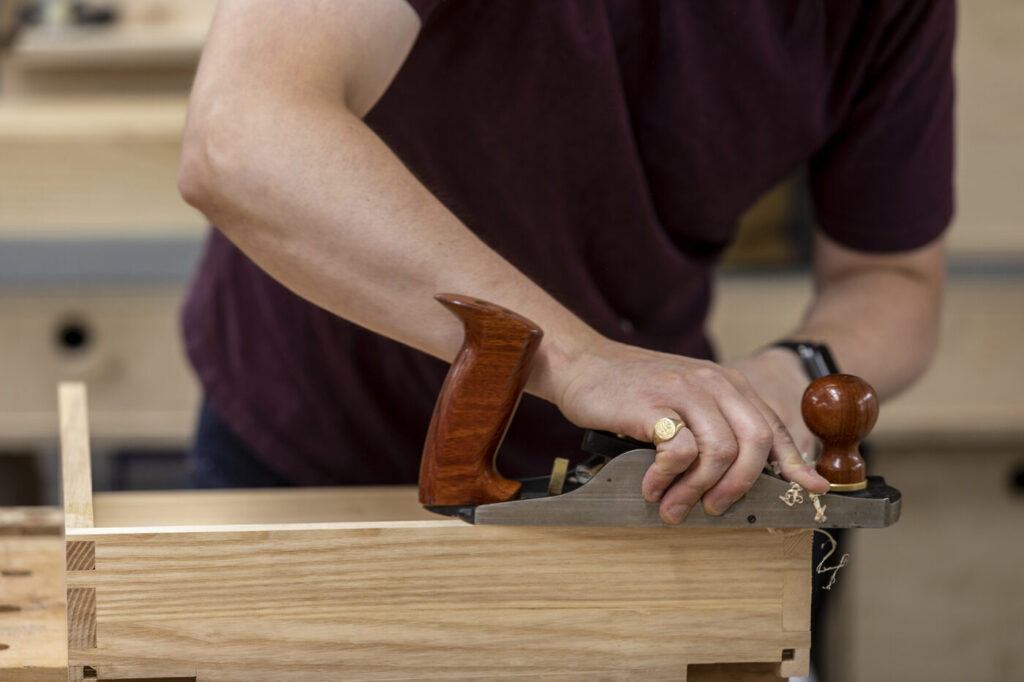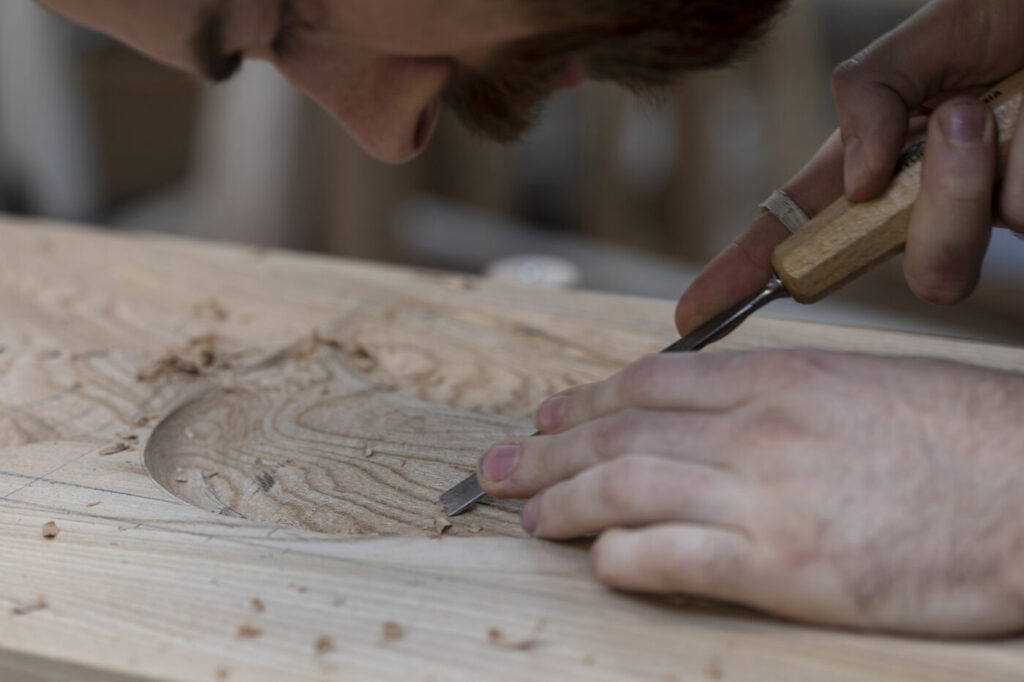Here at the Chippendale School, we offer our students the opportunity to explore a wide range of woodworking techniques from the traditional to the modern.
Each course is meticulously designed to provide students with a solid foundation in woodworking skills with our longer, more intensive courses exploring more intricate techniques.
Read on to learn more about the many woodworking techniques we teach our students.
Hand Skills
Let’s start with the basics! Hand skills in woodworking represent the fundamental and most traditional aspect of the craft. These techniques are the building blocks of woodworking mastery.
Wood carving is an ancient practice where woodworkers use cutting tools such as knives, or a chisel and mallet, to create sculptures and often detailed and intricate works of art. Our weekend spoon carving course allows students to explore this technique and learn the fundamentals of woodworking.
Another traditional practice we explore is the art of woodturning. Similar to the potter’s wheel, it allows the woodworker to sculpt a symmetrical piece of wood as it spins on an axis known as a lathe. We explore this technique in our weekend woodturning course where students have the chance to learn how to skilfully use a lathe as well as explore other basic woodworking techniques.
Design in woodworking is an element we encourage our students to explore. Popularised in the 16th century, parquetry involves the use of contrasting woods to create interesting patterns. Similarly, marquetry is the addition of intricate designs that sit on the surface of already existing wooden structures. Both techniques involve the cutting, fitting, and glueing of wood pieces into intricate patterns and can often include the addition of other materials, such as mother of pearl.

Modern developments
The integration of technology has revolutionised carpentry and it is something we do not shy away from here at Chippendale School. Embracing technology, we teach our students how to effectively employ modern developments into furniture making.
Technology can aid in the design process. Utilising CAD (Computer-Aided Design) allows woodworkers to design projects on a computer before bringing them to life. This along with teaching the skill of Perspective Drawing allows our students to see a realistic view of their piece before construction – making it easier to spot any design flaws or make necessary adjustments before construction begins.
Creating mock-up models of furniture before construction begins is a necessary woodworking technique for ensuring a piece is structurally sound. 3D printing aids in creating these models, ensuring students consider the structural integrity of their piece before construction can begin.
Beyond design, the introduction of tech in woodworking has made construction much more efficient. We teach our students how to effectively utilise machinery such as laser cutting machines and CNC Wood Carving Machines which automate carving, engraving, cutting, milling, and drilling on various materials, including wood. It is vital that students at the school understand the mechanics of these machines not only to ensure they run smoothly but to also ensure the utmost safety in the workshop.

Restoration
As a school, we also place a strong emphasis on ensuring the longevity of furniture. Through our restoration course, we offer students the chance to preserve and breathe new life into antique furniture. We also teach restoration on our Professional Course.
Construction
While design forms the foundation, true woodworking proficiency lies in bringing concepts to life. A fundamental skill we impart is furniture construction, which includes mastering the building of the core structure, known as “carcass construction.” Think of it as the skeleton of a piece, especially valuable in crafting storage units and cabinets. Through construction we teach various joinery techniques to create seamless and durable surfaces, ensuring each piece of furniture lasts a lifetime.
Teaching great wood construction also involves students learning how to manipulate wood. From steam bending, which sees the wood soften by applying steam, to kerfing, which involves making strategic cuts to bend wood without steaming, offering versatility in construction, we show pupils how materials can be shaped and manipulated.
Finishing Techniques
Whether using oil, wax or spray lacquer, selecting the right finish is crucial for preventing wood issues and deterioration. We ensure our students understand the importance of choosing the appropriate finish for wood preservation. In addition, we promote the use of natural products as much as possible such as linseed oil, tung oil or beeswax.
We encourage students to infuse their own creativity and add character to pieces be it through painting, gilding or material selection. We even have upholstery covered at the Chippendale School to add that added comfort to our furniture pieces through padding, springs, webbing, and fabric or leather covers! Our one-week upholstery course covers both traditional and modern upholstery techniques from horsehair to foam and is hugely popular.

Beyond Woodworking
We want to leave our students with the skills to not only create wonderful pieces of furniture but also to successfully run their own furniture-making business which is why our longstanding 30-week professional course is so intensive. This course is for anyone seeking to develop the skills to successfully manage their own furniture-making business, in addition to essential business skills such as pricing strategies, customer service, and marketing.
– – – –
You can explore these techniques and more on our 30-week Professional Course – we are still taking applications for our 2024/25 course – find out more here or get in touch with us today if you have any questions.
